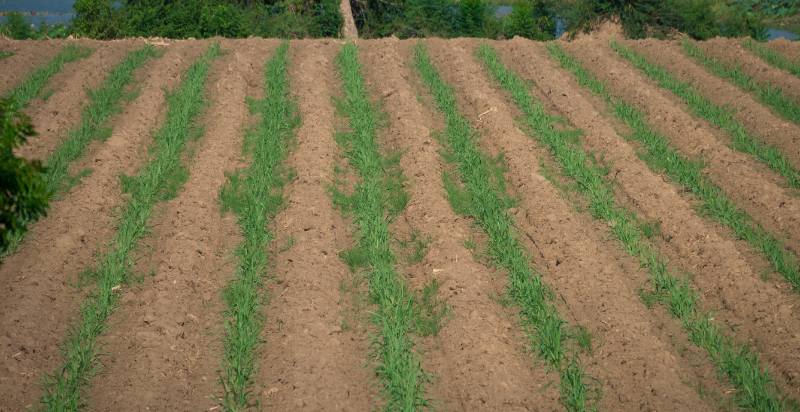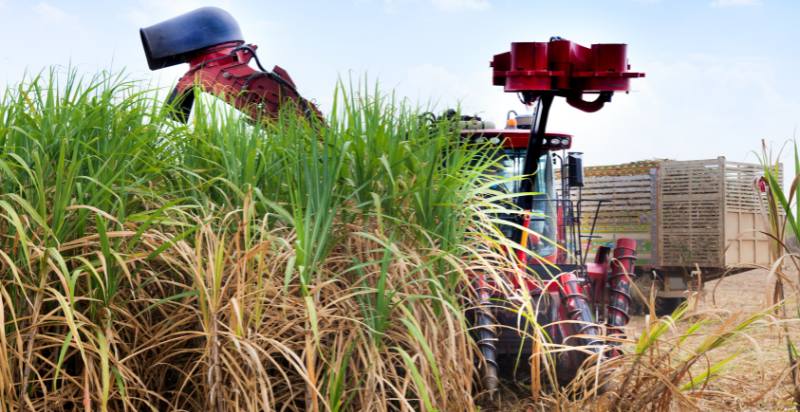Sugarcane is a sweet and fibrous plant that can be used for many purposes. It is easy to grow and care for, making it a great addition to any garden. This article will teach you everything you need to know about growing sugarcane plant. You will learn how to plant, care for, and harvest the delicious bounty it provides. So, let’s get started!
What is Sugarcane?
A tropical perennial grass called sugarcane produces several stems, typically 3 to 4 m (10 to 13 ft) tall and 5 cm (2 in) in diameter, by developing lateral shoots at the base. When fully developed, the stems develop into cane stalks, which make up about 75% of the overall plant. A mature stalk contains 63–73% water, 2-3% non-sugars, 11–16% fiber, and 12–16% soluble sugars.
The warm temperate and tropical parts of the Old World are home to sugarcane, a Poaceae family member. The plant is cultivated for sugar production. It thrives best in well-drained sandy loams or silty clays with high organic content and neutral to slightly acid pH. Commercial sugarcane cultivation varies between 20° latitude north and south of the equator, with optimum growth between 24° and 28° N/S.
History of Sugarcane:
The plant is believed to have originated in either New Guinea or the neighboring islands of Indonesia and, from there, spread through the South Pacific islands before eventually reaching India, China, and Southeast Asia. Several wild species of sugarcane are native to different parts of the world, but it is not known for certain which one was the progenitor of the cultivated crop. The most likely candidate is Saccharum robustum, a species native to mainland Southeast Asia.
Sugarcane has been an important crop in India for over 2,000 years. It is thought to have first been cultivated in the region that is now the state of Uttar Pradesh and, from there, spread to other parts of the subcontinent. The Arabs were the first to introduce sugarcane to the Mediterranean, quickly became an important crop in Spain, Italy, and Sicily. Its plantations were also established in the Atlantic islands off the coast of Africa and in Brazil and the Caribbean.
Name Origin Of Sugarcane:
The English word “sugar” is derived from the Arabic word سكر (sukkar). This, in turn, is likely to have originated from the Sanskrit word शर्करा (śarkarā), which referred to the juice of the sugarcane. The Hindi and Urdu words for sugar, चना (chanā) and چنا (chinnā), also come from this Sanskrit root.
Description Of Sugarcane:
Sugarcane is a tall, slender grass that can grow to a height of up to 10 m (33 ft). It has a thick, fibrous stalk that is composed of interwoven bundles of cellulose fibers. The leaves are long and narrow, with sharp edges. They are arranged in pairs on the stem, with each leaf sheath enclosing the next leaf in the pair.
The flowers are small and inconspicuous, borne in clusters on the lower part of the plant. They are followed by cylindrical fruits known as “sugar-canes” or “cane-rolls.” Each fruit is about 20 cm (8 in) long and 5 cm (2 in) wide and contains several large, hard seeds.

Cultivation Of Sugarcane:
Tropical and subtropical parts of the world are where sugarcane is grown. It requires a warm climate with abundant rainfall and fertile soils. The crop is grown on both small-scale family farms and large commercial plantations.
In most sugarcane-producing countries, the crop is harvested by hand. The canes are cut with a knife or machete, and the cut ends are stripped of their leaves. The canes are then gathered into bundles and transported to the milling area.
At the mill, the canes are first crushed to extract their juice. This juice is then boiled to drive off excess water, leaving behind a thick syrup known as “molasses.” The molasses is further refined to produce sugar crystals, which are then sold as granulated sugar or used to produce other food products such as alcohol.
Uses Of Sugarcane:
Sugarcane is an important source of sugar and other sweeteners. It is also used to make paper, ethanol, and biofuels. The stalks can be used as fuel for power generation. The residue from the milling process (known as “bagasse”) is often used as animal feed or burned to generate electricity.
The plant’s leaves can be used as fodder for livestock, and the stem can be used to make baskets and other handicrafts. In some parts of the world, the sap from the sugarcane plant is used to make a type of wine known as “toddy.”
It is also an important crop in India and China’s traditional systems of medicine. Its juice treats many ailments, including indigestion, diarrhea, and fever. The plant’s roots are believed to have medicinal properties and are sometimes used in the treatment of snakebites.
What Are The Health Benefits?
Sugarcane juice is a refreshing drink rich in vitamins, minerals, and antioxidants. It has numerous health benefits, including boosting energy levels, aiding digestion, preventing kidney stones, and reducing cancer risk.
Sugarcane juice is also a good source of hydration. It contains electrolytes like sodium and potassium, which help to replenish the body’s fluids and prevent dehydration. Its juice has a high sucrose concentration, making it a natural sweetener. It can be used as an alternative to sugar in many recipes.
When choosing sugarcane juice, it is important to select a product that is 100% pure and does not contain any added sugars or artificial flavorings. It is also important to avoid its juice that has been heat-treated, as this process can destroy many of the beneficial vitamins and minerals.
How To Grow Sugarcane?
To grow sugarcane, you will need a warm climate with plenty of rainfall and fertile soil. The crop is typically planted in late spring or early summer.
It can be grown from seed but is more commonly propagated from cuttings. Choose healthy stalks of sugarcane at least 2-3 feet tall to take cuttings. Cut the stalks into about 18 inches long pieces, and plant them in rows that are spaced about 4 feet apart.
Water the plants regularly, and fertilize them every few weeks with a high-nitrogen fertilizer. Harvest the sugarcane when the stalks are at least 3/4 inch in diameter and 8-10 feet tall.
It can be harvested by hand or with a machine. If you are harvesting by hand, cut the stalks at the base with a knife or machete. If you are using a machine, such as a cane harvester, the stalks will be cut and collected automatically.
Once the sugarcane is harvested, it will need to be processed within 24 hours to prevent spoilage. The first step in processing sugarcane is to extract the juice. This can be done by crushing the stalks in a mill or pressing them in a juice extractor.

Here are some additional tips on how to grow Sugarcane :
Climate
Sugarcane is a tropical plant that thrives in warm, humid climates. It cannot tolerate frost or prolonged periods of drought. The ideal temperature range for sugarcane growth is between 77 and 86 degrees Fahrenheit. Sugarcane can be grown in USDA hardiness zones 8 through 11.
Soil
Sugarcane prefers loose, sandy soil that is well-drained. The pH level of the soil should be between 5.5 and 6.5. It will not grow well in clay soils or overly wet soils.
Planting
Sugarcane is typically planted in the spring or early summer. The plants should be spaced about 3 to 4 feet apart. Once sugarcane has been planted, it can be replanted yearly. The plants will produce new stalks from the root system each year.
Sugarcane requires a lot of water and fertilizer to grow well. The plants should be watered regularly, especially during dry periods. Fertilizer should be applied every few months during the growing season. It is susceptible to several pests and diseases, so it is important to monitor the plants closely and treat any problems.
Pests and diseases
Sugarcane is relatively resistant to pests and diseases, but a few can cause problems. The most common pests are aphids, mealybugs, and whiteflies. These insects feed on the sap of the sugarcane plant, weakening it and reducing the crop quality.
Aphids can be controlled with insecticidal soap or neem oil. Mealybugs can be controlled with beneficial nematodes. Whiteflies can be controlled with yellow sticky traps or by releasing predatory beetles into the field.
The most common disease of sugarcane is “smut.” This fungal disease causes black spots to form on the leaves and stalks of the plant. Smut can be controlled with fungicides.
Another disease that can affect sugarcane is “leaf scald.” This bacterial disease causes the plant leaves to turn yellow and eventually die. Leaf scald can be controlled with copper sulfate or streptomycin.
Harvesting And Storage
Sugarcane can be harvested by hand or machine. If you are harvesting by hand, cut the stalks at the base with a knife or machete. If you are using a machine, such as a cane harvester, the stalks will be cut and collected automatically.
Once the sugarcane is harvested, it will need to be processed within 24 hours to prevent spoilage. The first step in processing sugarcane is to extract the juice. This can be done by crushing the stalks in a mill or pressing them in a juice extractor.
The juice is then boiled to drive off excess water, leaving behind a thick syrup known as “molasses.” The molasses is then boiled again to drive off more water, leaving behind a thick, dark-colored syrup known as “blackstrap molasses.”
Blackstrap molasses can be used as a sweetener or an animal feed ingredient. It can also be further processed to extract sugar crystals.
Sugarcane can be stored for several months if it is properly processed and stored. To store sugarcane, the stalks need to be cut into 3-4 feet long pieces. These pieces can then be stored in a cool, dry place.
If you want to store it for longer, it can be processed into “gur.” Gur is a type of Indian candy made from sugarcane juice that has been boiled down to thick syrup. Gur can be stored for up to 12 months if it is kept in an airtight container.

How to Use Sugarcane:
Sugarcane is a versatile crop that has many uses. It can be consumed fresh, juiced, or processed into various products. Whether you are growing sugarcane for your own use or commercial purposes, it will surely add sweetness to your life!

Conclusion
If you are looking for an interesting and unique plant to grow in your garden, sugarcane is a great option. It is relatively easy to care for and can be rewarding once it starts producing cane. Make sure to give your sugarcane plenty of water and sun, and fertilize it regularly for the best results.
- Everything You Wanted to Know About Red Tamarillos - June 2, 2025
- A Guide to Tulips: Everything You Need to Know & More… - June 2, 2025
- Guanabana: Description, Flavor, Benefits, And Uses - May 27, 2025

1 thought on “Sugarcane Plant: How to Plant, Grow, and Care for Sugarcane”
Comments are closed.